9 de August de 2021
Sport VBT Sensor Encoder. How to Use the VBT System for Velocity-Based Training
What is Velocity-Based Training?
Velocity-Based Training (VBT) is a fantastic tool for strength and conditioning coaches and professionals around the world. VBT allows you to optimize your training, it is the only way to know objectively what is happening in the weight room. The fundamental premise of VBT is to measure speed to control the two most important variables of training intensity and training volume. VBT is so important because science has shown that not quantifying what you do in the weight room can cause athletes to make progress far below what they can achieve, or even worse.
According to science, velocity-based training is the best way to optimize strength training in the gym.
In other sports, quantitative training techniques have existed for many years, not only at the professional level but also at the amateur level. For example, in football, it is often seen that GPS is placed on the back or chest of football players to know how many kilometers they have run, how many sprints they have done, etc. In cycling, for example, we can see how they use the potentiometers to control the power zones in those who are pedaling so that they can plan their exercises correctly and, among other things, ensure that they are not overly fatigued.
The same thing happened in the weight room, as demonstrated by scientific and empirical evidence. Each weightlifting must be measured to ensure that the athlete’s efforts are in line with the coach’s plan [1,2], so that he will not be overly fatigued, and try to generate the highest possible speed and strength during each repetition, and improve its performance. In this way, the transfer to your specific sport will be higher.
This method of quantifying and measuring what is happening in the gym is called velocity-based strength training. As I mentioned before, it has a lot of scientific evidence. More than 1,700 studies have been conducted in this area, and the conclusions are very clear. Even VBT courses are taught at the University of Sports and Physical Activity Science. If I had to define what velocity-based strength training is, I would say that this is the only way to ensure that the load programmed by the coach is the same as what the athlete perceives during training. In other words, this is the only accurate way to know that what is programmed on paper is implemented in the gym. Without velocity-based training, we’re like blindfolded, we don’t know what we are doing.
How is this achieved? Measuring the velocity of the lift. There is a direct correlation between the velocity at which the athlete moves the barbell and the strength represented by the weight. [3,4] When you increase the weight of a barbell, no matter how fast you try to lift it, it will slow down each time it moves because it costs more. Therefore, if you know the speed at which you move any weight, you will know exactly what percentage of 1RM it is, or in what zone of your load-velocity profile you are moving.
Why does it play such an important role in weight training?
Why are traditional methods (such as the 1RM test) proven to be inaccurate and vary greatly in terms of programming load and intensity?
Performing periodic tests requires a great amount of time, and not everyone can use it. In addition to requiring a lot of effort, these tests can also produce excessive degree of fatigue and can be harmful.
They are imprecise, especially for the inexperienced, because they are not able to apply all possible forces. [3,4] The 1RM varies greatly according to various factors such as weather, time, motivation, fatigue, stress, etc. This is because the nervous system is never constant. Therefore, it is very random, and specific tests cannot set the tone for all your training days. [3,4]
I’m going to give you a very simple and graphical example that you will easily understand:
Suppose today we perform a 1RM bench press test on an athlete, and his 1RM is 100 kg. On the paper, we wrote down his 1RM and listed the weight he will train in the next few weeks. Let’s say, tomorrow you have to use 90% of 1RM to do 2 sets of 2 repetitions, which is 90 kg. As we can see in the figure below, under real conditions, 1RM changes every day, depending on the different reasons I explained above. What would happen if the athlete has a poor rest and he has no strength to come, his 1RM today is 93 kg instead of 100 kg? Well, logically, he will fail in the first series, and if he tries to do the second, he will also fail. What does failure mean? Well, as you already know, in addition to burdening your plan, the risk of injury increases dramatically, and fatigue skyrockets, increasing the risk of injury in certain sports and possibly reducing your performance. This is undoubtedly the worst case and one that we must avoid at all costs.
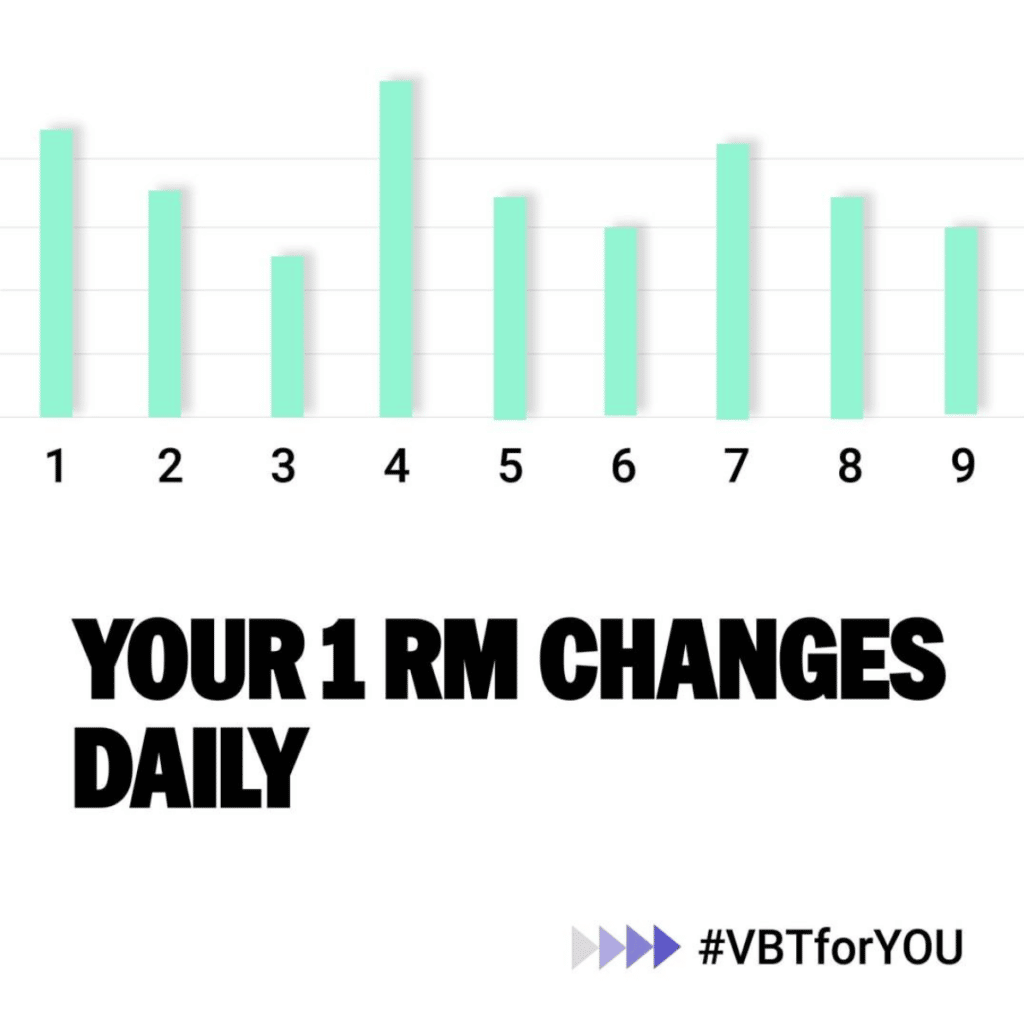
The solution would be to use a sport linear position transducer to measure the velocity of each repetition. In this same example, if we had used velocity-based training, during the athlete’s warm-up, the encoder would have told us that his 1RM today is 93 Kg (Without having to lift it, it estimates the 1RM through the velocity of a light lift, and with great precision.) instead of yesterday’s 100 Kg, and therefore today, instead of putting 90 Kg on the bar, we would have put 90% of 93 Kg, which is 83.7 Kg, and the athlete would be raising its 90% of the REAL 1RM, 90% of that same moment.
This is just one of the uses of velocity-based training, I’ll give you other articles where we explain the importance of measuring the loss of velocity within the series to quantify and adjust the fatigue accumulated by the athlete, increasing this mode the effectiveness of each set, and also the importance of giving athletes feedback on their weight lifting velocity, which, according to scientific studies, it can make them gain twice as much strength.
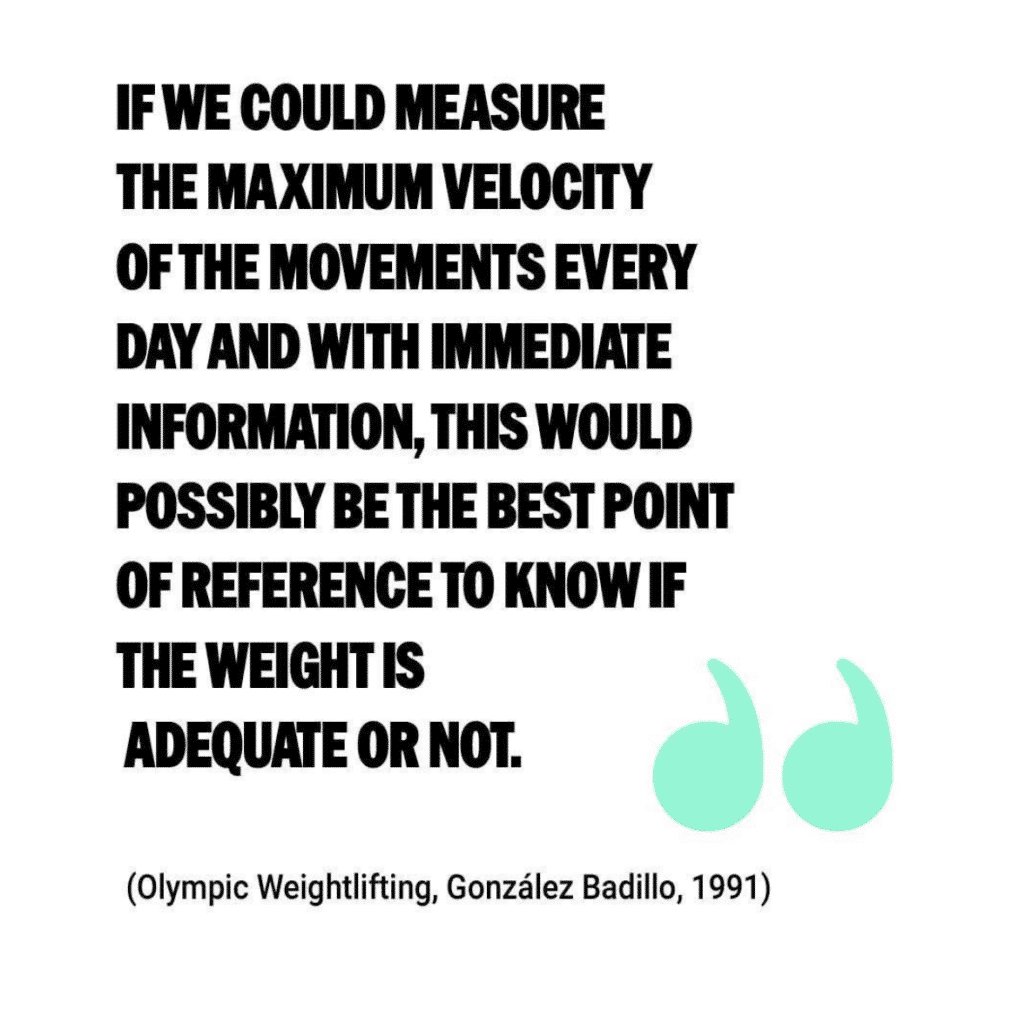
“If we could measure the maximum velocity of the lifts every day and with instant information, this would probably be the best reference point to know if the weight is adequate or not.”
González-Badillo, J. J. (1991). Halterofilia. Comité Olímpico Español.
Velocity and percentages of RM
In order to solve the problem of 1 RM and nRM as reference data in dosage and programming loads, execution velocity is an fundamental element, because neuromuscular improvement and training effects are largely affected by the speed of load movement.
In this sense, the “type” table is very useful for understanding the differences related to load and movement. If you have a Vitruve device, it’s really very simple. During the warm-up, which will be closely related to the exercise or movement that we want to measure, you will choose 4 types of loads, from low loads to very high loads. In this way, the application will create your own personal curve through some equations, and when you perform “X” exercises, your personal and exclusive percentages will be fully insured. Interestingly, we will re-evaluate our speed curve to adapt to the load about every half month.
Every day we can handle the load that can be lifted because we know that every day our athletes or ourselves have different work capacities. The encoder will provide us with an accurate load, at the speed we want to process that day.

We must also bear in mind that being normative and generic, they have a slight problem because we are not exactly the same, and there is a certain degree of variability between people. For this reason, it is recommended to create your own power-velocity profile. With the Vitruve encoder, you can make your own profile of all exercises with just 5 lifts. A load-velocity profile is basically the speed at which you are able to move a certain percentage of your 1RM. The advice given when creating a velocity profile is a logical progression of a certain percentage of a maximum repetition for a given lift. This could be 3 to 6 lifts with different weights. For example, you could use 50, 60, 80, 85% of 1 RM. This will allow you to have a wide uniform velocity range, which will generate a complete velocity profile and we will know how fast each percentage of our athletes moves. It is important to emphasize again that the relationship between the percentage load of the maximum number of repetitions and the speed varies between athletes and between different exercises.
The load-velocity profile is not only intended to estimate the 1RM or to know the speed at which an athlete lifts each% of his 1RM, but also serves to evaluate whether the athlete is improving his profile throughout the weather. If you repeat this test with the same weight after 3 months, you can quickly see whether the athlete has increased the speed of that weight. After all, this is the goal of any athlete to mobilize the same weight. The loading speed is faster, or in other words, more force can be generated under the same resistance.
Loss of velocity in the series: the degree of fatigue
Knowing the fatigue or the degree of effort of a series helps us know if the workload is at its best. Excessive fatigue has been shown to negatively affect athletes’ performance, make their recovery worse, and therefore may increase their risk of injury in certain sports. On the other hand, insufficient work will not improve everything that athletes can do.
For all of this, velocity-based training provides a very clear solution. Using the velocity of the first repetition and the speed loss in the series can give us the clearest and most direct data. As a direction in the table below, we can see a simple relationship between the speed loss and the number of possible repetitions.

Feedback
One of the great benefits of velocity-based strength training is its ability to provide real-time feedback to an athlete during training. As a coach, we could target metrics like maximum power, maximum velocity, average power, average velocity, just to name a few. This real-time information will stimulate the athlete’s enthusiasm and try to increase each repetition at the maximum possible speed to generate the maximum possible strength, thereby achieving the highest quality of all repetitions and allowing him to gain more strength.
This provides a powerful associative learning paradigm for establishing psychological feedback loops. This is related to training psychology, which essentially produces greater success in your plan, because by providing feedback on what they are doing, no matter how much burden they have on the bar, they will always try their best. Fortunately, this is not only what we have seen in all customers, but science has also proven it. Lifting each representative as quickly as possible can give any athlete more power than simply lifting. Moreover, this is where VBT makes sense. It has been shown that by providing athletes with feedback on their lifting speed, it allows athletes to lift as many times as possible without knowing it. As fast as possible.
Self-regulation
When we use self-regulation in training, we are referring to a capacity management system that regulates the ability of a particular individual to work. The VBT allows us to meet the individual needs of each athlete while making instant adjustments to any training parameters. One of the most common mistakes in training is that we use an arbitrary percentage that represents the maximum repetition value (% RM). This does not fully represent the athlete’s current training preparation state, which may cause major problems in the management and appropriateness. It is important to understand that every athlete will improve at his own pace, and his performance changes every day, depending on many variables that we cannot control (rest, diet, personal problems, motivation…). As coaches, our job is to be able to understand the daily state of each athlete, so as to adjust the load according to their actual situation, so that the stimulation of training is ideal. Using tools like VBT, we can avoid these problems because we provide real-time accuracy through various feedback methods provided by VBT. Ultimately, we strive not to overtrain or let our athletes go too far, because we will significantly increase the risk of injury and, as mentioned in various scientific studies, will reduce their performance.
What types of velocity-based training devices are there?
In order to measure the velocity of the bar, logically, you need a device that can measure it. There are different technologies on the market, some of which can do this precisely, while others just promise to do it, which is far from accurate and useful for velocity-based strength training.We can divide these technologies into 3 groups:
1. Camera-based technology:
Generally speaking, they are much more expensive than other technologies. What is done is to measure the speed of the rod through image recognition. According to recent research, they are not very accurate. As a personal opinion, considering the price, the installation required, and the accuracy provided, I do not recommend them. [5]

Mounted workbench, bar and camera system with 3D motion capture markers. [5]
2. Technology based on accelerometer:
They are very small devices with integrated IMU, which can measure the acceleration of the bar and indirectly measure the speed. To be honest, due to their small size and portability, they are the most comfortable devices to use. But in this case, it is no longer just my opinion, but the latest scientific evidence. In all the accuracy tests performed on these devices, it is determined that THEY ARE NOT ACCURATE OR CONSISTENT AT ALL, so they are of no use. I have tried it myself. They, and have talked to countless coaches who have used them, we all agree on the same thing, they fail repeatedly, and the speed is almost random. Facing the same investigation, these devices showed different speeds. Considering the difference caused by the VBT difference of 0.01m/s, it is absurd to use a technology with such a huge error.

Accelerometer attachment to the barbell. (9)
3. Linear encoder technology:
It is the “GOLD STANDARD” technology of VBT. There is no doubt that it is the most accurate and powerful technology on the market, the technology used in most scientific researches, and the technology used by professionals. Until a few years ago, its only drawback was the price, and in some cases a laptop was required to use it. But today this is no longer a problem.
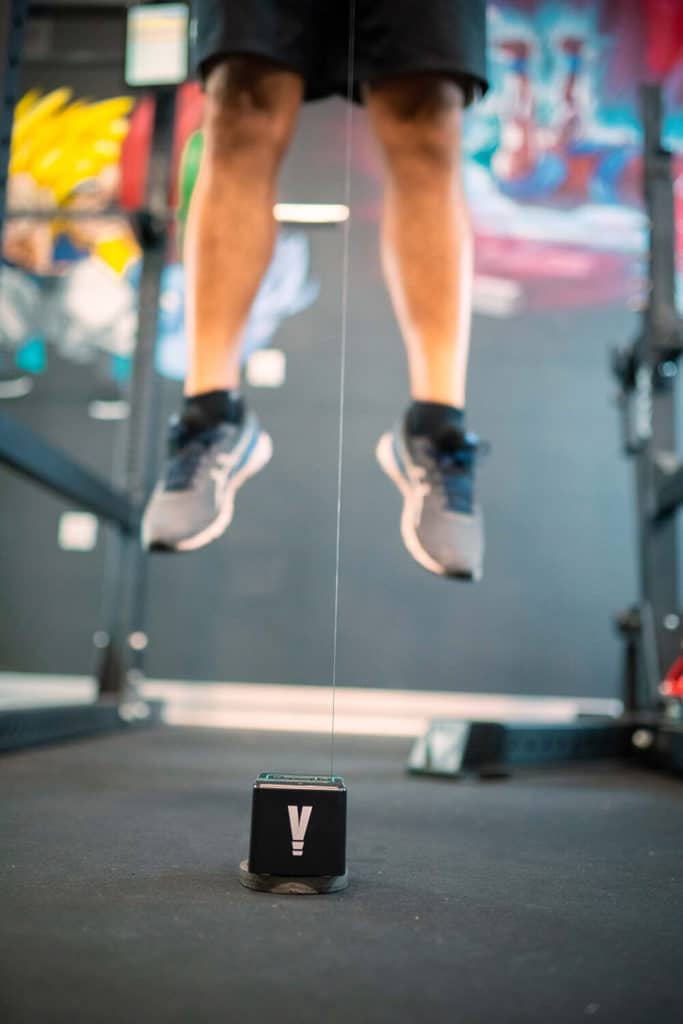
Vitruve Linear VBT Encoder
How to choose the right VBT device?
There are certain questions that every coach has to ask when buying a VBT device. The first thing is to find out whether the device in question has published scientific research in high-impact journals (such as JSCR) to prove the accuracy and consistency of its measurements. This is the most important point, any device that does not fit it (There are a lot on the market than they seem) should be discarded. Emphasize the importance that the research has been published in high-impact journals and well-known researchers, otherwise, we will not be able to ensure the validity of the research. I made a comment because some companies published their own “research” on their website, where they “showed” their accuracy, but there is still no serious research to prove this.
For example, the purpose of this study published in JSCR [6] is to compare the reliability and effectiveness of seven devices available on the market to measure the velocity of movement during a bench press exercise. The variability of measured values that occurs between different repetitions in the device is also studied. In conclusion, it is determined that the Vitruve encoder is the most accurate, and it is also the encoder recommended by the researchers for VBT. They also added that you must use accelerometers carefully because they have errors.
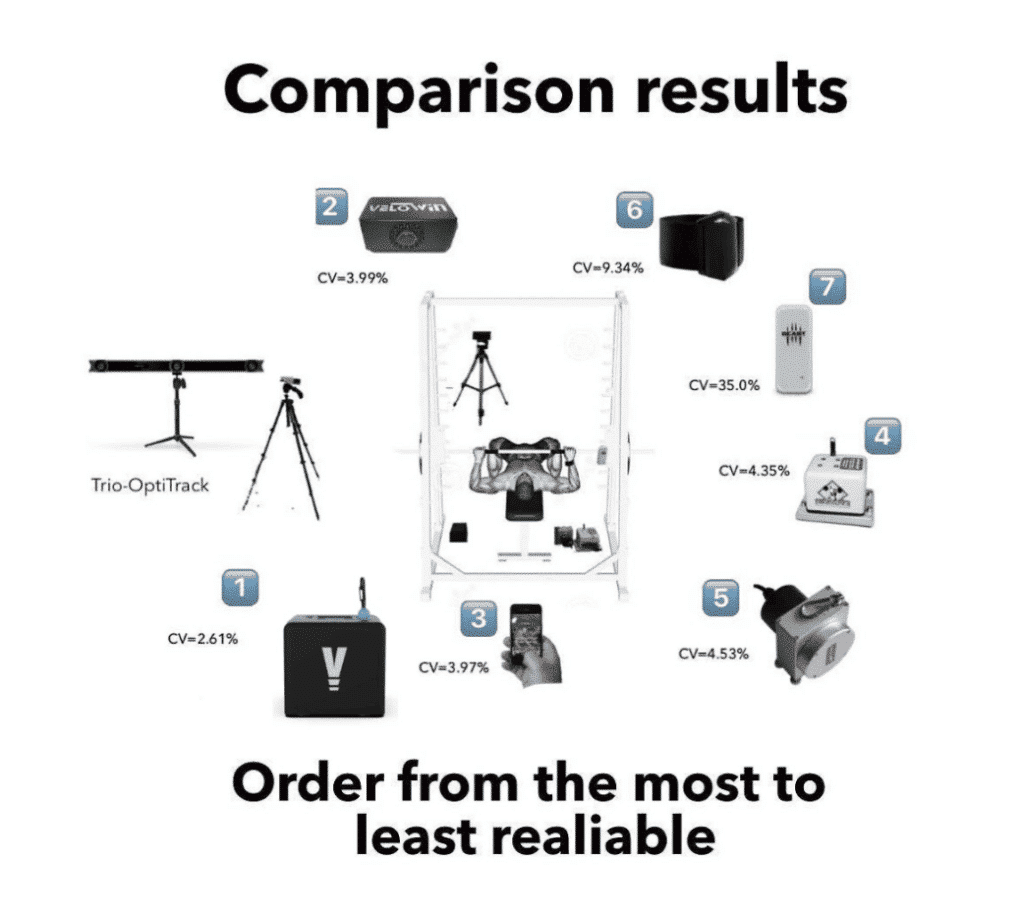
Pérez Castilla, Alejandro & Piepoli, Antonio & Delgado García, Gabriel & Garrido, Gabriel & García Ramos, Amador. (2019).
Once its reliability has been verified, you must look for a fast and easy-to-use device that comes with an intuitive application that can save data in the cloud so that you don’t lose it and provide you with the best important information, and that your athlete can handle it. To be able to verify this, you can look up tutorials on the use of the device, or depending on the company, see if they offer a guaranteed one-month return to test it in a real environment.
Finally, if you train with multiple athletes at the same time, you may need multiple devices, and most importantly, an application allows you to manage multiple athletes on different devices at the same time. The coach needs about 1 piece of equipment for every 3-5 athletes in order to make their training smoother and able to quantify them all. This is why, based on the available budget, you are still more interested in one brand than another.
Velocity-based training devices for team training
The progress of VBT is most notable in its use in teams or large working groups. Many devices on the market, whether due to their limited portability or complex applications, prevent teams from effectively integrating velocity-based training into their workouts.
If you work with a team, you will know how limited time is and how organized all athletes must train to do what they must do. In this case, you must choose the technology well.
On the one hand, it must have an application that allows multiple athletes to train at multiple sites at the same time. The transition from one athlete to another must be very fast, and it must also be very simple so that the athlete can process the application with a few instructions. The application must be able to upload data to the cloud in real-time so that all iPads/mobile phones in the gym can record all the information of all athletes. For example, athletes can perform different exercises on different platforms without confusion or loss of information.
For example, if you train 25 athletes at the same time, you will need 5-6 devices to equip all workstations. At the same time, you will have a total of 5-6 athletes lifting weights, each athlete has its own encoder, and each athlete has its own application. As a coach, it is almost impossible for you to manage 6 applications at the same time, so it must be managed by the athlete.
Another advantage of VBT is that athletes get motivated and compete with each other, creating a competitive environment that allows them to squeeze every lift. Some apps like ours allow the creation of a leaderboard where athletes can compete based on speed or strength and the relative strength generated. According to our customers, the changes in the training environment are incredible.
Why choose Vitruve?
When we created Vitruve, there were already expensive and less portable encoders, as well as inaccurate accelerometers. One thing we know is very clear, that is, we will not do imprecise things, and we will not sell poor quality things to our clients.
In addition, we have been and will continue to be very aware of the importance of VBT to any athlete, and we hope to achieve an easy-to-use tool that can be used even by teams with less time available. On the other hand, most teams and coaches have very limited budgets. One of the challenges we face is to achieve as precise as the most expensive, very easy-to-use, and very economical technology.
To this day, we can proudly say that we have achieved this goal. Our device has been verified by JSCR as the most accurate device on the market (compared with 6 other devices). To validate it, it was compared with the gold standard Tri Opti Track system, which consists of a high-resolution 3D positioning camera.
We have thousands of customers all over the world, from professional teams such as the Cleveland Indians, Atletico de Lisbon, and Atletico Madrid to the American Football Federation, most of the Spanish Federation, hundreds of Olympic athletes, to Sports training in centers like Beimel Elite Track and Field Center.
The best part is that we have achieved that not only professional teams use it, but also amateurs.https://www.youtube.com/watch?v=kwAzhNkeb2U&ab_channel=Vitruve
[banner_device_1]
Advantages of measuring your exercises with the Vitruve velocity-based training device
If you are reading this article, you may already know something about VBT, but in any case, I will summarize the benefits of velocity -based strength training for you.
At the beginning of this article, I explained the importance of measuring execution speed and its relationship with intensity, but I did not mention how we can use this relationship to our advantage.
The three main problems it solves are as follows: adjustment of the intensity, adjustment of the volume and improvement of the athlete’s motivation, so that he can produce the greatest possible strength in each repetition.
1.- We already know that it is not recommended to lift 1RM during training sessions because of the high risk of [3,4] injury and because of the fatigue it produces on athletes. Using the Vitruve encoder, you can create a profile of each athlete, fully personalize it to estimate their daily 1RM, without having to approach failure.
In addition, with this profile, you can understand which areas your athletes work in, because depending on the sports they are engaged in, you will be interested in exercising in certain power zone or other areas.
2.- One of the problems with traditional training methods is to program the repetitions that each athlete must do. This is a problem because several athletes, even though they use the same percentage of 1RM, if they all do the same number of repetitions, they will not be equally tired and their efforts will be different. The only way to be able to program and control this effort is to quantify the fatigue of the series, which is done through the loss of speed in the series.
One of the advantages provided by being able to control fatigue is that you can ensure that your athlete is not overly fatigued and does not affect his performance. It has been shown that fatigue of more than 20-25% will not bring the benefit of increased strength, so it does not make sense to continue to repeat beyond fatigue, because we will only make the athlete tired and reduce his performance.
3.- The third important point that the VBT solves is the intention of each lift. I can assure you that almost all athletes who do not use VBT will not lift each repetition as quickly as possible, that is, he will not generate all the power that they can develop in each lift.
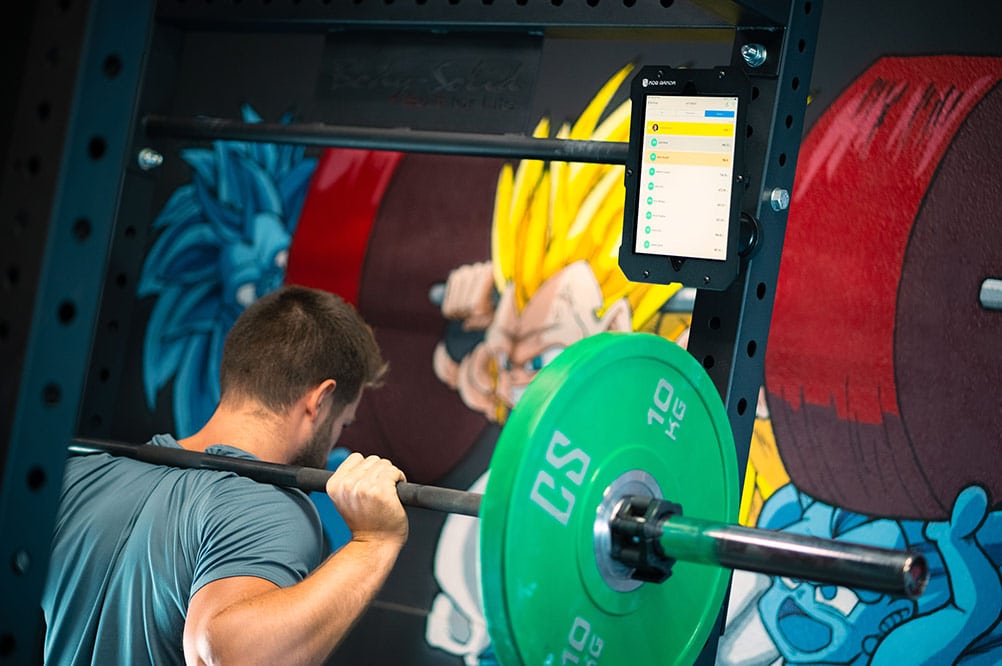
This would not be a problem if it weren’t for the fact that science has shown that you can improve up to twice as much if the maximum possible speed is applied in each repetition.
This is very important to us, so we added auditory and visual feedback.
By checking how fast you are improving, we will automatically complete all repetitions as quickly as possible, you will be stung unknowingly, and the training environment will be completely changed.
The athlete stopped doing the series to be completed and started to compete with himself in each weightlifting, which greatly improved his performance.
It may sound bad for us to say this, but as objective as possible, we believe that Vitruve is the best VBT device you will find.
We created it after considering all the problems with the devices on the market, and we managed to have a very cheap device, very easy to use, and most importantly, super precise.
In addition, we are pretty sure you will like it, so we offer a 30-day fully guaranteed return. You can order your Vitruve. Once it arrives at home, you will have 30 days to test it with your athletes in the gym. If we can’t convince you for any reason, you can return it to us and we will refund Your money.
Guidelines for starting VBT from 0
In this article, we have seen on the one hand what are the three main problems that speed-based strength training solves, and how to choose effective tools to apply these three points.
If you have no experience with VBT, you may think that implementing all of these is too complicated, and you will be overwhelmed by all the information we provide to you. But don’t worry, because this is normal, and this has happened to many coaches I have talked to over the years. In fact, we have realized that in any field, there is a learning curve, and it is meaningless to go from 0 to 100 in a day.
For this reason, and analyzing which ones can get the most benefit from VBT and which ones are the easiest to implement, we developed a pyramid indicating the steps to implement VBT step by step and finally master it in a short period of time.
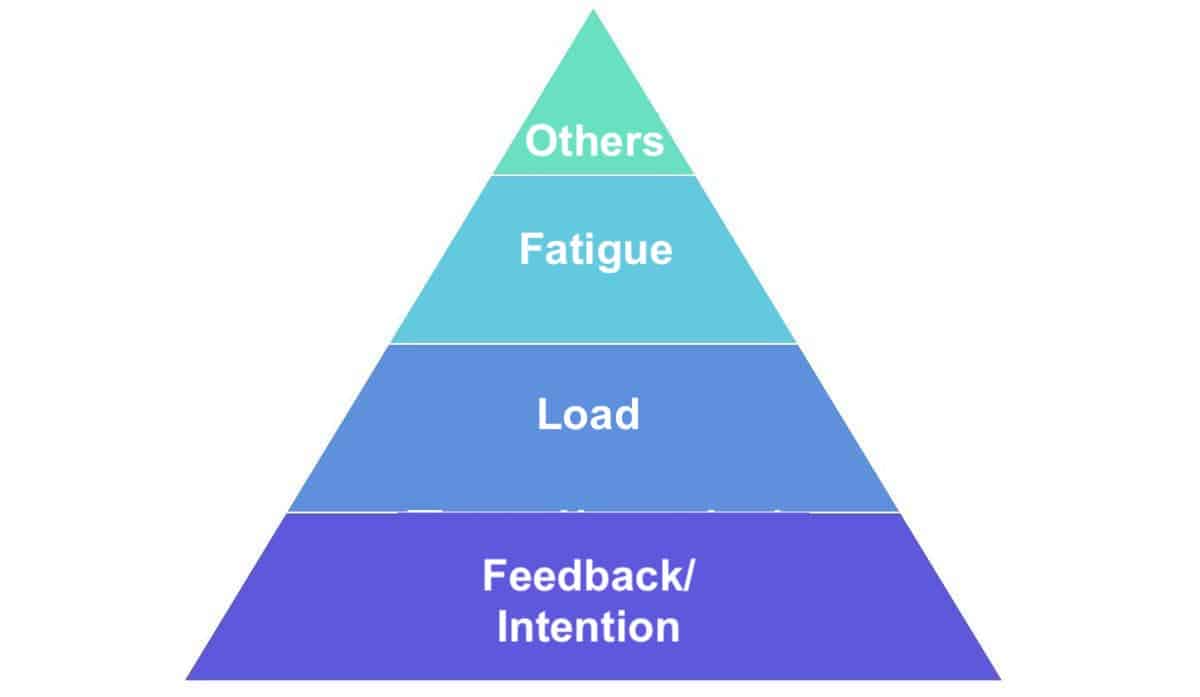
As you can see in the pyramid above, we believe that feedback is what gives us the most benefit in the gym because it provides cost/benefit. Without having to change the current training program, simply by putting the encoder in front of the athletes, you will see how they start to get motivated and lift the bar much faster so that they can make more progress.
Since it is very simple to implement, I suggest that you first put the encoder screen in front of the athletes, simply give them feedback and ask them not to slow down as much as possible.
Once the athlete is used to applying the highest possible speed in each repetition, and once you are satisfied with the application, you can skip to the second step.
In the second step, you have 2 options, one of which is to use the formula provided by the app to estimate the daily 1RM of each athlete in order to understand how much weight should be placed on the bar during each training session. The second option is to never estimate 1RM and always use the speed zone. Using the above table to show the different percentage speeds of 1RM in different exercises, you can know that if you want your athlete to train, such as his 80% squat, he should put a weight on his barbell to be 0.68m/s. Once the athlete finds that weight, you will know that he really used 80% of his 1RM.
Speed zones can be more difficult to understand since the vast majority of coaches are used to speaking and programming based on a percentage of 1RM. But the advantage of speed zones is that they do not need to estimate 1RM, because if the estimation is wrong for different reasons, the athlete will not use the percentage corresponding to his 1RM.
Finally, once you are able to let each athlete determine the weight, he should place on the bar by estimating his 1RM or through the speed zone, you can begin to quantify fatigue.
[banner_guide]
As with step 2, there are two ways to do it. If in step 2, you adjust the estimated athlete’s 1RM load through the default profile or through the individualized load velocity profile of each athlete (this is more advanced, I think this may not be the best explanation in this article) So, in order to be able to adjust the fatigue of each series, you must set a velocity loss. This percentage must be between 5-25%, because as we have seen before, your athlete’s fatigue can be counterproductive.However, if you are using a velocity zone, you only need to increase the cutting velocity, and once the athlete falls below that velocity, they will complete their set. For example, if we require the athlete’s velocity to be 1m/s and we want him to be 10% fatigued, we will activate a speed zone between 1-0.9 m/s, and when the athlete decelerates, he will accelerate below 0.9m/s. Will accumulate 10% fatigue. The way you see it is exactly the same, but the way it is expressed is different. We especially like using the velocity zone, it saves a lot of time for athletes and makes the instructions simpler.
Finally, we have the fourth point “other”, which is basically a lot of testing and experimentation using encoders. For example, by analyzing the range of motion of a group of athletes, you can check whether he has an automated technique, because excessive changes in the range of motion mean that the athlete cannot do two equal repetitions.
This fourth point covers a lot of uses, but I think for now, with the 3 basic steps I explained to you, they are enough.
To summarize, these are the guidelines that you must follow to gradually start implementing VBT. You must remember that unless you feel comfortable and feel you can control it, you cannot move on to the next point:
1.- Only use feedback and get the athlete to lift as quickly as possible
2.- Adjust the weight by estimating 1RM or velocity.
3.- Adjust fatigue by velocity loss percentage or velocity zone.If you have any questions after reading the article, please write to us and we will help you! In addition, I recommend that you check our YouTube channel because we are starting to upload content here.
References
- González-Badillo, J. J. (1991). Halterofilia. Comité Olímpico Español.
- Jovanovic M, and Flanagan EP. (2014). Researched applications of velocity based strength training. J. Aust. Strength Cond. 22(2)58-69. https://www.researchgate.net/publication/265227430_Researched_Applications_of_Velocity_Based_Strength_Training
- Zourdos MC, Dolan C, Quiles JM, Klemp A, Jo E, Loenneke JP, Blanco R, Whitehurst M. Efficacy of daily 1RM training in well-trained powerlifters and weightlifters: a case series. Nutr Hosp 2016;33:437-443. https://www.researchgate.net/publication/284179354_Efficacy_of_Daily_1RM_Training_in_Well-Trained_Powerlifters_and_Weightlifters_A_Case_Series
- Izquierdo, M., Ibañez, J., González-Badillo, J. J., Häkkinen, K., Ratamess, N. A., Kraemer, W. J., French, D. N., Eslava, J., Altadill, A., Asiain, X., & Gorostiaga, E. M. (2006). Differential effects of strength training leading to failure versus not to failure on hormonal responses, strength, and muscle power gains. Journal of applied physiology (Bethesda, Md. : 1985), 100(5), 1647–1656.
- McGrath, Gary & Flanagan, Eamonn & O’Donovan, Paul & Collins, Dj & Kenny, Ian. (2018). Velocity based training: Validity of monitoring devices to assess mean concentric velocity in the bench press exercise Journal of Australian Strength and Conditioning ASCA. Journal of Australian Strength and Conditioning ASCA. 26.
- Pérez Castilla, Alejandro & Piepoli, Antonio & Delgado García, Gabriel & Garrido, Gabriel & García Ramos, Amador. (2019). Reliability and Concurrent Validity of Seven Commercially Available Devices for the Assessment of Movement Velocity at Different Intensities During the Bench Press. The Journal of Strength and Conditioning Research. 33. 10.1519/JSC.0000000000003118.
- Mann, B., Kazadi, K., Pirrung, E., & Jensen, J. (2016). Developing explosive athletes: Use of velocity-based training in athletes. Muskegon Heights, MI: Ultimate Athlete Concepts.
- Badillo, J. J. G. (2017). La velocidad de ejecución como referencia para la programación, control y evaluación del entrenamiento de fuerza. Ergotech.
- Sato, Kimitake & Sands, William & Stone, Michael. (2012). The reliability of accelerometry to measure weightlifting performance. Sports biomechanics / International Society of Biomechanics in Sports. 11. 524-31. 10.1080/14763141.2012.724703.

